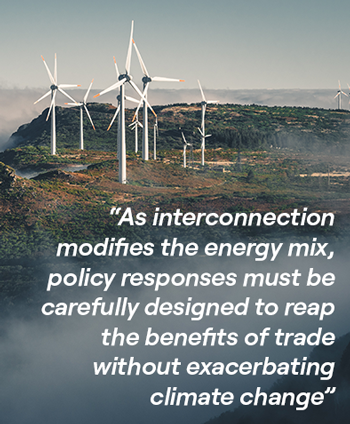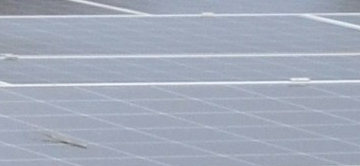Electricity links between remote producers and energy-thirsty cities could deliver huge efficiency gains. Should expanded regional networks and international ‘supergrids’ also be part of a joined-up approach to fighting climate change? Stefan Ambec, Director of the TSE Energy and Climate Center, discusses his latest research with TSE alumna Yuting Yang (University of New Mexico) on electricity trade and climate policies.
How does electricity differ from other tradeable goods?
Electricity is a homogeneous good, meaning that electricity produced in any region or from any energy source are perfect substitutes, but its trade flow is physically constrained by transmission capacity. When produced by intermittent renewable sources such as wind and solar power, electricity generation is also dependent on weather.
Why are policymakers keen to increase cross-border electricity links?
Electricity trade offers improved efficiency and access to cheaper, more diversified energy sources. Research has shown that a national grid system could reduce US carbon emissions by up to 80%. Energy security and geopolitical concerns are also pushing policymakers to develop more reliable and resilient supply networks following Russia’s invasion of Ukraine.
By allowing regions that support renewables to export green electricity, interconnection can both enhance efficiency and mitigate climate change. If areas with a renewable energy surplus are connected to those with high energy demand, electricity trade can help to overcome the intermittency problem and reduce the carbon footprint of areas that lack renewable resources or infrastructure.

However, outside the EU, most countries have failed to coordinate carbon policies. This undermines the climate benefits of interconnection as it is difficult to control the carbon content of imported electricity. For example, 70% of carbon emissions from electricity used in California leak outside its borders because its cap-and-trade system has not been adopted by connecting states. Renewable intermittency adds to the challenge of designing efficient policies that account for weather-dependent trade flows.
How does your research approach this issue?
Many countries and regions now price carbon emissions through taxation or emissions trading schemes. However, trading with a region that has a lower or no carbon price results in carbon leakage. We investigate such policies in the context of limited electricity interconnection. Specifically, we examine the extent to which carbon pricing and other market-based climate policies can reduce emissions from electricity generation when a trading partner does not regulate emissions. Our modeling considers a transmission link from a ‘foreign’ region that exports fossil-fuel electricity to a ‘home’ region that generates both fossil-fuel and intermittent renewable energy.
What are your main results?
We find that electricity trade raises consumption of foreign fossil fuels, reducing the effectiveness of carbon pricing. Importing carbon-intensive power also constrains green investments due to trade-induced competition. This effect is exacerbated by the increased profitability of investing in interconnection capacity at higher carbon prices.
Investment in renewables can be boosted by introducing a carbon border adjustment mechanism (CBAM) to raise the cost of imported power. A CBAM or higher transmission prices can reduce carbon leakage by leveling the playing field domestically, but not abroad. The CBAM must therefore be complemented by domestic subsidies to increase renewable generation. The interconnection is then used to export surplus renewable power. Investment in interconnection can thus be leveraged to decarbonize electricity consumption abroad where carbon emissions are not priced.
If it undermines carbon pricing, should electricity trade be limited?
 Electricity interconnection is vital for energy security and efficiency. Trade can lead to a more competitive market, enabling consumers to benefit from cheaper energy sources abroad. Resiliency is improved by allowing countries to share during shortages or emergencies. Interconnection also facilitates the diffusion of renewable sources, optimizing their use and balancing intermittency. However, as interconnection modifies the energy mix of connected countries, policy responses must be carefully designed to reap the benefits of trade without exacerbating climate change.
Electricity interconnection is vital for energy security and efficiency. Trade can lead to a more competitive market, enabling consumers to benefit from cheaper energy sources abroad. Resiliency is improved by allowing countries to share during shortages or emergencies. Interconnection also facilitates the diffusion of renewable sources, optimizing their use and balancing intermittency. However, as interconnection modifies the energy mix of connected countries, policy responses must be carefully designed to reap the benefits of trade without exacerbating climate change.
What are some of the potential avenues for future research?
Our paper assumes that climate policies and the merit order – the optimal sequence for plants to deliver power – are fixed in external markets. These assumptions could be relaxed to investigate how foreign energy mixes adjust to a new climate policy. However, this would require endogenizing the climate and trade policies of all trading partners within a game-theory framework.
The policies we analyze – carbon pricing, CBAM, transmission prices and rights, and renewable subsidies – should be carefully coordinated, as they have different impacts on the energy mix, interconnection and trade. We would like to see research into the optimal combination of such policies on a case-by-case basis, depending on the country’s objectives.
FURTHER READING
‘Climate policy with electricity trade’ (2023) and other publications by Stefan are available on his TSE web page. His work with Claude Crampes investigates how renewable sources impact the optimal energy mix, exploring different policy instruments, demand-side responses, and storage technologies. Claude’s recent research on how to maximize the potential of interconnection was covered in the January edition of TSE Reflect.
Article published in TSE Reflect, May 2023





